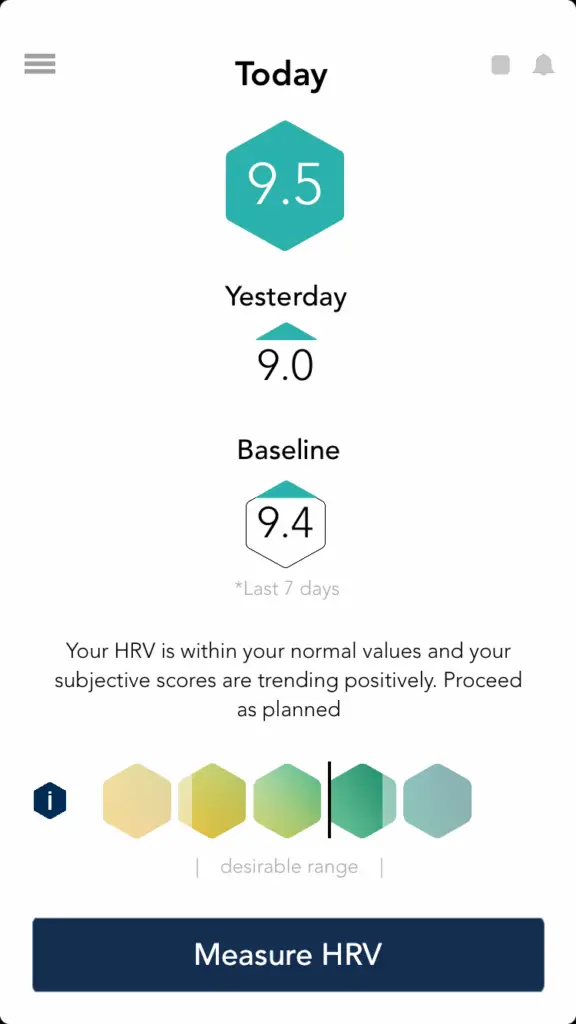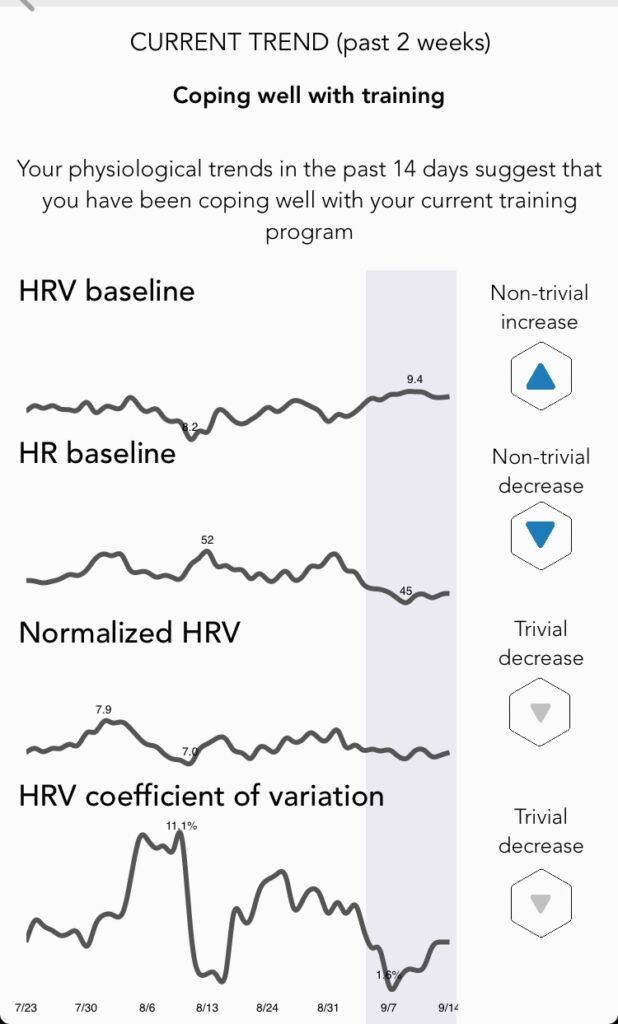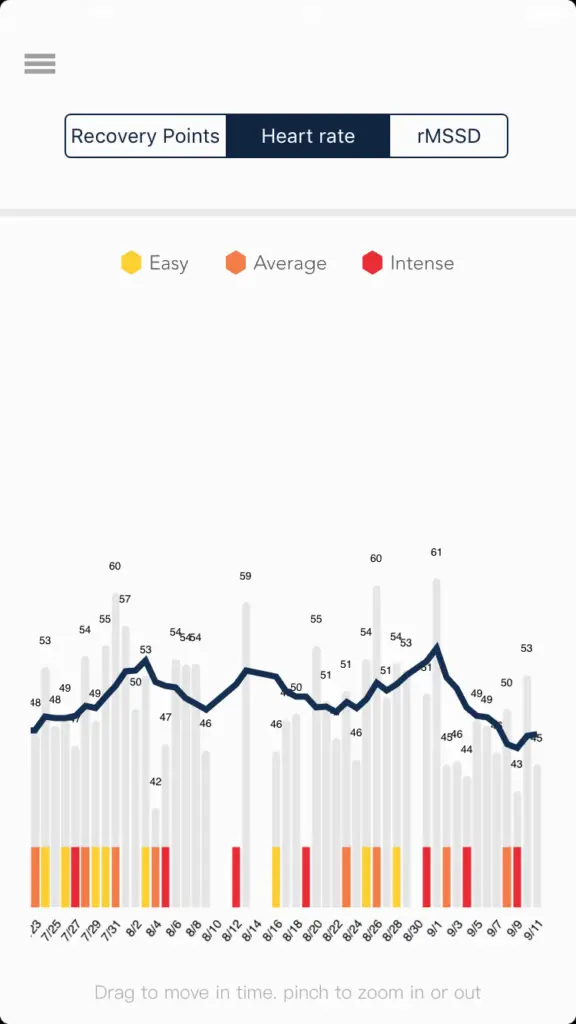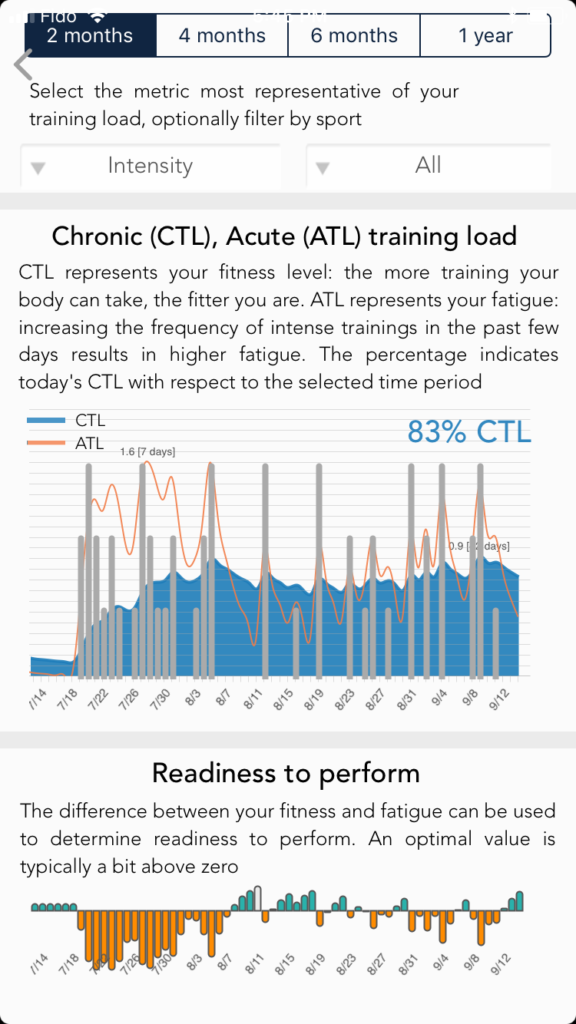How much training is enough? How much training should you do today? Did you recover from yesterday’s exercise? Are you coping well with your training or not?
Many of these questions can be answered by using heart rate variability and resting heart rate. Heart rate variability has become an extremely important biomarker in sport and exercise. However, it is not always easy to interpret these data.
Let’s see how we can use both for training.
Heart rate and recovery
Heart rate can be used as an indicator of recovery. If you have done a strenuous workout on Monday, your heart rate will likely be elevated on Tuesday. This is a good sign that you are recovering and should limit your training intensity. Your heart rate should be back at base level before doing another intense workout.
If your heart rate is elevated following a strenuous workout you are likely still recovering.
Many things influence your heart rate. Fatigue, sickness, caffeine, posture. To get the most out of your measurements take your heart rate at the same time every day.
I recommend measuring your heart rate in the morning before you start your day. That means prior to having any food or drink other than water, and prior to checking your e-mail, messages, and so forth.
What is heart rate variability?
Heart rate variability is the variability in the timing between heart beats. If you have a heart rate of 60 beats per minute your heart beats are timed about a second apart. But they are not exactly one second apart, there is a base level of variability between those heart beats.
That base level of variability is heart rate variability, and is an indicator of how well your body can deal with different stressors.
Heart rate variability is a treasure trove of information for the serious athlete. The downside is that it is a bit more sophisticated and tricky to interpret than just the heart rate.
But what is a good heart rate variability? Well, that is totally relative. In simple terms, your heart should have some, but not too much, natural variability. A heart that is as accurate as a metronome cannot deal with stressors very well, but neither can a heart that beats with too much variability.
Day to day variation in heart rate variability
Day to day variation in heart rate variability (HRV) is an indicator of how well your body is coping with different stressors. On some days you might feel fantastic but have a very high or low HRV. This can be a sign of mental stress, impending sickness, or something else. Usually it is a good idea to take it easy on these days.
The day after an intense lactic training HRV can be low, again indicating that you should take it easy. However, you might become sore after an a-lactic workout too which is not always reflected in HRV. This instead will likely be reflected in your heart rate measurement.
For some people, day to day variation in HRV is fairly minimal. If you are already a well-trained athlete, you might not see a big decrease in HRV following a strenuous workout. Or maybe… you could have trained harder.
Long-term variation in heart rate variability
Long term changes in HRV are commonly related to training adaptation. This makes HRV such a powerful tool for the serious athlete, you can gauge whether your training has the right physiologic effect. If your training is effective your average HRV should increase. If your training is not effective HRV will decline over time and you will need to adjust your training regimen.
- A long-term decrease in HRV may indicate you are not coping well with training
- A long-term increase in HRV may indicate you are coping well with training
Long term variation in coefficient of heart rate variability
The coefficient of HRV (cHRV) is essentially the variation in your daily HRV measurements. Believe it or not, this is the variability of your heart rate variability and is another useful measure of how well you are adapting to your training. Studies on endurance athletes indicate that cHRV decreases with training.
- A long-term decrease in cHRV indicates you are coping well with training, but might also indicate risk of overtraining.
- A long-term increase in cHRV indicates you are not coping well with training.
Heart rate variability and heart rate: long term training effects
Using HRV, cHRV and heart rate together gives you a more complete picture than HRV or heart rate on their own.
- Good training program: long-term HRV increase, long-term heart rate decrease
- Bad training program: long-term HRV decrease, long-term heart rate increase
- cHRV decrease: increased risk of overtraining(?) or coping well with training
Of course it is never that easy to take data and interpret it. HRV might decrease while HR goes up during tapering prior to a competition, and there are other factors that affect these metrics.
How to use heart rate variability and heart rate to determine training load
There are several apps to measure HRV and heart rate. I have only used HRV4Training and have found it to be very useful. The measurement can be taken with a smartphone camera so you don’t need any extra devices.
I use HRV religiously to determine my daily training load and also use the correlations and insights to gauge long-term training effects.
There are undoubtedly other apps that also work, but I haven’t tested them. I am not affiliated with HRV4training in any way.
Here are some examples:




It’s not always simple
Heart rate variability and heart rate may sometimes be confusing. For example, I do not see a significant decline in HRV after a heavy day of training, so the HRV4training app will tell me to ‘proceed as planned’ even though I might be feeling very sore.
‘Proceed as planned’ in this case just means doing what my body tells me to do: a break or a very light workout.’
‘Hidden’ stressors also have an effect heart rate variability and/or your training. For example, an important work meeting coming up, or trouble in the family. Your HRV might be lower than expected without you knowing the cause.
Qualitative health metrics
HRV4 training incorporates qualitative health metrics very well. You can use a variety of tags to indicate your motivation to train, sleep and other metrics.
Another neat thing is that you can gauge for example how much alcohol impacts your HRV. The app includes a tag for alcohol (none, a little, or too much). But what is a little?
I know from my data that if I have more than two drinks in the evening, HRV is significantly lower the next day. No more than two before a day of diving for me.
You can also use custom metrics and log them in the app. For example, I do one breath hold every morning and log the number in seconds. You could also log your SaO2 or any other metric.
How do you keep track of your health stats? Let me know in the comments.





great article.
thanks for sharing
Thanks, glad you liked it!